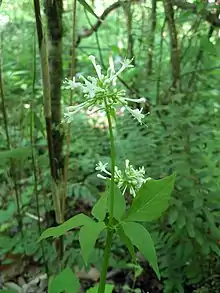Valeriana pauciflora
Valeriana pauciflora, commonly called the largeflower valerian,[1] is a plant species in the Caprifoliaceae. It is native to the Eastern United States, where it is found in the regions of the Interior Low Plateau, the Ohio River drainage, and the Potomac River Valley.[2] In this region, it is found in very nutrient-rich, mesic forest communities, often in stream valleys or lower slopes.[3]
| Valeriana pauciflora | |
|---|---|
 | |
| Scientific classification | |
| Kingdom: | Plantae |
| Clade: | Tracheophytes |
| Clade: | Angiosperms |
| Clade: | Eudicots |
| Clade: | Asterids |
| Order: | Dipsacales |
| Family: | Caprifoliaceae |
| Genus: | Valeriana |
| Species: | V. pauciflora |
| Binomial name | |
| Valeriana pauciflora | |
Valeriana pauciflora is a conservative perennial restricted to high-quality habitat. It produces white through light pink flowers in late spring and early summer.[4] This species can set seeds without insect pollination, and also might be cross-pollinated by butterflies [5]
The specific epithet pauciflora, is Latin for 'few flowered'.[6][7]
References
- USDA, NRCS (n.d.). "Valeriana pauciflora". The PLANTS Database (plants.usda.gov). Greensboro, North Carolina: National Plant Data Team. Retrieved 11 October 2015.
- "Floristic synthesis map" (PNG). Bonap.net. Retrieved 9 October 2015.
- Flora of the Southern and Mid-Atlantic States
- Illinois Wildflowers
- Barrows, E. M., A. F. Howard, and B. W. Steury. 2011. Phenology, insect associates, and fruiting of Valeriana pauciflora Michaux (Valerianaceae) in the Potomac River Gorge Area of Maryland and Virginia, United States. Marilandica 2 (2): 6–10.
- Allen J. Coombes The A to Z of Plant Names: A Quick Reference Guide to 4000 Garden Plants, p. 106, at Google Books
- D. Gledhill The Names of Plants, p. 220, at Google Books
This article is issued from Wikipedia. The text is licensed under Creative Commons - Attribution - Sharealike. Additional terms may apply for the media files.